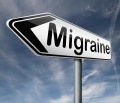Migraine Headache
Migraine headaches are a common health issue that can be extremely debilitating. Often sufferers are unable to carry out daily activities including occupational responsibilities. The presentation of migraines varies greatly, and causative factors can be complex. It is estimated that in the United States over 28 million individuals suffer from chronic migraines, with an estimated 157 million workdays lost each year due to migraine symptoms.[1]
|
Migraine Headache | |
| Causes | Dietary Factors, Allergies, Environmental Toxins, Insomnia |
|---|---|
| See Also | Neurological Conditions, Headaches, Stroke, Seizures, Depression, Anxiety |
| Books | Books on Head, Ears, Nose and Throat Conditions |
| Articles | Articles on Head, Ears, Eyes, Nose and Throat Conditions |
Contents
Naturopathic Assessment
Causal Factors
In order to stimulate the innate ability of the body to heal the causes of disease must be identified and addressed. With migraines, the causes are variable and include lifestyle and environmental factors. A detailed assessment is required to determine which factors are triggering migraine headaches. The factors that trigger migraines overlap with those that trigger headaches. Only those factors that are unique to migraines are listed below. For a complete list refer to the headache section.
Lifestyle
- Dietary factors are implicated with migraines in a number of different ways:
- Several studies have demonstrated the role of food allergy or intolerance in the development of migraine headaches. Foods commonly implicated include cow's milk, wheat and eggs.[2]
- Foods containing vasoactive compounds including cheese, beer, and wine may initiate a migraine headache in some individuals.[2]
- Glycemic dysregulation is common in North American diets, and can lead to the development of migraine headaches.[2]
- The ingestion of aspartame can trigger a migraine headache in some individuals.[3]
| Check out this book | 50 Ways to Control Migraines : Proven Relief for Adult, Adolescent, and Child Migraine Suffers (50 Ways...Series) |
|---|
Medical Interventions
- Prescription Medications
Genetics
| Article | Topical Capsaicin Reduces Migraine Pain in a Randomized Trial , 2010 June Natural Medicine [1] |
|---|
- Family History
- A family history of migraines is present in up to 90% of cases, suggesting a hereditary component.[4]
Related Symptoms and Conditions
Conditions related to migraine headaches include:[5]
- Tension-Type Headache
- Affective Disorders
- Stroke
- Seizures
- Depression
- Anxiety
Characteristics
The diagnostic testing for migraines is similar to that of headaches.
Migraine headaches can be subdivided into several categories based on causative factors and presentation. One simple way to categorize migraines defines four sub groups as follows: migraine with aura, migraine without aura, probable migraine, and chronic migraine. [5]
- Migraine with aura refers to reversible focal symptoms that occur before the onset of the migraine itself, are reversible, and last less than 60 minutes. These symptoms often include seeing bright lights, or vision loss. Some individuals experience neck stiffness, fatigue, concentration difficulty, light sensitivity, pallor, blurred vision, and/or nausea as part of a migraine premonition.
- Migraine without aura occurs without any preceding signs or symptoms.
- Probably migraine does not completely fulfill the criteria for a migraine headache but is not attributable to any other disorder.
- Chronic migraine refers to an individual that experiences migraine attacks on 15 or more days a month.
The common signs and symptoms of migraines include:[4], [1]
- Distention of scalp blood vessels
- Pallor
- Nausea
- Photosensitivity
- Ptosis
- Dilated pupil(s)
- Muscle weakness
- Impaired vision
- Visual scotoma
- Hemianopsia
- Unilateral or throbbing headache (hours to days)
Naturopathic Treatment
| Article | Efficacy of Vitamin B3 and its related Coenzymes for the Treatment of Bell's Palsy, Huntington's Disease, Migrain and Chronic Tension-Type Headaches, Multiple Sclerosis, Parkinson Disease, and Tinnitus J Orthomolecular Med 2012;Vol27(2) |
|---|
The goal of naturopathic treatment is to support and work in tandem with the healing power of the body and to address the causal factors of disease with individual treatment strategies. Migraines are typically a chronic disease and require long term modification of lifestyle factors. The strategy for migraines is similar to that for headaches. For a complete look at the treatment options check out the section on headaches.
It is always advisable to work with a naturopathic doctor before engaging in any treatment plan.
References
Reviewed by Iva Lloyd, BScH, RPE, ND [2]
- ↑ 1.0 1.1 Prousky Jonathan (2008) Principles and Practices of Naturopathic Clinical Nutrition CCNM Press.
- ↑ 2.0 2.1 2.2 2.3 Sudak N, Murray MT, Pizzorno JE. (2006) Pizzorno Textbook of Natural Medicine 3rd ed Chap 191 Migraine Headache Elsevier.
- ↑ Koehler SM, Glaros A (1988) The effect of aspartame on migraine headache Headache; 28:10-14
- ↑ 4.0 4.1 4.2 Boes CJ et al (2008) Bradley: Neurology in Clinical Practice 5th ed Chap 73 Headache and Other Craniofacial Pain Butterworth-Heinemann
- ↑ 5.0 5.1 Sadovsky RS, Dodick DW (2005) Identifying migraine in primary care settings Am J Med;118 suppl1:11-17
